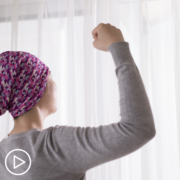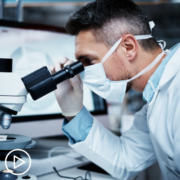An Overview of CLL Treatment Types
An Overview of CLL Treatment Types from Patient Empowerment Network on Vimeo.
What are the treatment types for chronic lymphocytic leukemia (CLL)? Dr. Matthew Davids details each type of treatment – and which type of patients some treatments may be most appropriate for.
Dr. Matthew Davids is Director of Clinical Research in the Division of Lymphoma at Dana-Farber Cancer Institute. Learn more about Dr. Davids here.
Related Resources:

|

|
Transcript:
Katherine:
Well, once it’s time to treat, of course, then it’s time to think about treatment options. Let’s walk through the types of treatments that are used today to treat CLL.
Dr. Davids:
As I alluded to before, we historically have had chemotherapy-based approaches to treat CLL. And that was an effective way to temporarily put the disease into remission, but it had a lot of side effects and inevitably the CLL would come back. And the challenge particularly with chemotherapy-based approaches it that when the CLL does come back after chemotherapy, it tends to behave more aggressively and be harder to treat.
So, there have been quite a few studies over the last few years trying to figure out ways that we can avoid using chemotherapy as the first treatment, and this can involve treatments such as monoclonal antibodies. People may have heard of rituximab or a newer drug, obinutuzumab. There are the inhibitors of the B-cell receptor pathway, and this is for example ibrutinib (Imbruvica), which targets a protein called BTK, also a newer one called acalabrutinib (Calquence), which targets BTK. And then, I mentioned at the beginning these fixed-duration therapies that stop after a period of time. Many of those are based on a newer oral drug called venetoclax (Venclexta), which when we give it as a first therapy, we give in combination with that antibody obinutuzumab (Gazyva).
So, a bit of an alphabet soup. I know it gets confusing with all the different treatments, but the good news for CLL patients is, 1.) we have a lot of options, which is great, 2.) we don’t necessarily need to use chemotherapy anymore, and in fact I use it pretty rarely these days. One situation where I do still consider chemotherapy is for younger patients – which in the CLL world is sort of under age 60 or so – if they have very favorable biology to the disease, in particular this mutated IGHV.
That’s a scenario where the older chemotherapy regimen, FCR, can be very effective. It’s a six-month treatment, and we have patients with those molecular characteristics who are now 12, almost 15 years out from their initial six months, and they’re still in a complete remission. So, many of those patients have been functionally cured of their CLL from the six months of treatment. But again, there are some risks to that approach. We worry about other cancers that may be more likely after receiving FCR. We worry about infections, and particularly in the COVID situation, we worry about COVID infection in patients on chemotherapy.
So, it’s been pretty rare that I’ve been using that approach these days. I’ve been opting more for the novel agent-based approaches. So, often now the conversation as an initial therapy comes down to, “Do you prefer more of a continuous treatment strategy with a BTK inhibitor drug like ibrutinib or acalabrutinib, or do you like the idea of a time-limited therapy with one year of venetoclax in combination with obinutuzumab?” And I would say there’s pros and cons to both approaches, and we don’t know which one is the optimal one for CLL patients to start with, but probably I think most patients at some point in their lifetime are going to need one therapy or the other.
So, maybe in the end it doesn’t matter too much which one you start with if you’re going to get both eventually anyway. But we don’t know that yet.




